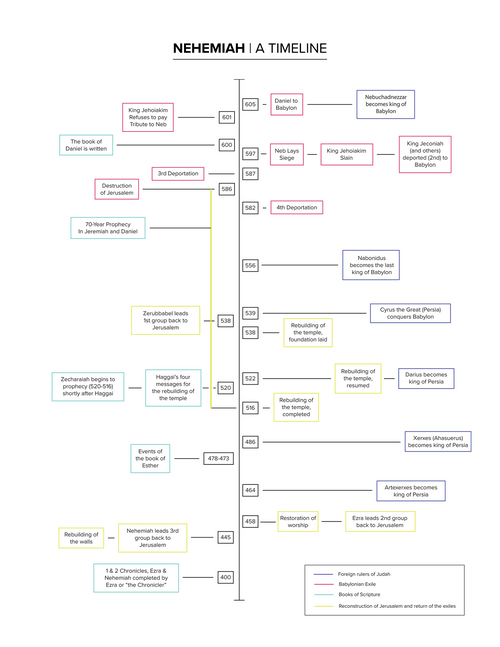Nehemiah : WK 4 - WED
Teamwork
Nehemiah 3:1-3
Then Eliashib the high priest and the other priests started to rebuild at the Sheep Gate. They dedicated it and set up its doors, building the wall as far as the Tower of the Hundred, which they dedicated, and the Tower of Hananel. People from the town of Jericho worked next to them, and beyond them was Zaccur son of Imri.
The Fish Gate was built by the sons of Hassenaah. They laid the beams, set up its doors, and installed its bolts and bars.
V6-7: The Old City Gate was repaired by Joiada son of Paseah and Meshullam son of Besodeiah. They laid the beams, set up its doors, and installed its bolts and bars. Next to them were Melatiah from Gibeon, Jadon from Meronoth, people from Gibeon, and people from Mizpah, the headquarters of the governor of the province west of the Euphrates River.
V13: The Valley Gate was repaired by the people from Zanoah, led by Hanun. They set up its doors and installed its bolts and bars. They also repaired the 1,500 feet of wall to the Dung Gate.
Nehemiah’s third chapter consists of various names of individuals and groups working to rebuild the broken walls of Jerusalem—fairly boring stuff. However, we discover that the work is often done in groups, by teams. In fact, as we move through the passage, we encounter the phrases, “worked next to them” (v2, 7, 9, 19), “beside him” (v4), and “next to him” (v10, 16, 17, 20). The words “then” and “next” are similarly used to create the mosaic of a continuous chain of workers. This isn’t a list of separate builders; it is a portrayal of a massive team.
While ineffective teams yield disappointing results, productive teams significantly surpass the collective capabilities of their individual members. This observation is frequently made and is pertinent to our reflection on God’s plans for His church. It might be beneficial to contemplate why certain teams achieve such high levels of effectiveness.
Many years ago, Kurt Lewin documented a groundbreaking study on the power of synergy: the act of two or more organisms to produce a result that each is individually incapable of achieving. Here are some of the impressive reasons he uncovered.
Other studies suggest that individuals who engage in functional teams report higher levels of happiness than those who do not. Ultimately, God’s call to participate in His body is not only beneficial for His kingdom; it also leads to a better life for us.
I invite you to “work next to them”.
Nehemiah 3:1-3
Then Eliashib the high priest and the other priests started to rebuild at the Sheep Gate. They dedicated it and set up its doors, building the wall as far as the Tower of the Hundred, which they dedicated, and the Tower of Hananel. People from the town of Jericho worked next to them, and beyond them was Zaccur son of Imri.
The Fish Gate was built by the sons of Hassenaah. They laid the beams, set up its doors, and installed its bolts and bars.
V6-7: The Old City Gate was repaired by Joiada son of Paseah and Meshullam son of Besodeiah. They laid the beams, set up its doors, and installed its bolts and bars. Next to them were Melatiah from Gibeon, Jadon from Meronoth, people from Gibeon, and people from Mizpah, the headquarters of the governor of the province west of the Euphrates River.
V13: The Valley Gate was repaired by the people from Zanoah, led by Hanun. They set up its doors and installed its bolts and bars. They also repaired the 1,500 feet of wall to the Dung Gate.
Nehemiah’s third chapter consists of various names of individuals and groups working to rebuild the broken walls of Jerusalem—fairly boring stuff. However, we discover that the work is often done in groups, by teams. In fact, as we move through the passage, we encounter the phrases, “worked next to them” (v2, 7, 9, 19), “beside him” (v4), and “next to him” (v10, 16, 17, 20). The words “then” and “next” are similarly used to create the mosaic of a continuous chain of workers. This isn’t a list of separate builders; it is a portrayal of a massive team.
While ineffective teams yield disappointing results, productive teams significantly surpass the collective capabilities of their individual members. This observation is frequently made and is pertinent to our reflection on God’s plans for His church. It might be beneficial to contemplate why certain teams achieve such high levels of effectiveness.
Many years ago, Kurt Lewin documented a groundbreaking study on the power of synergy: the act of two or more organisms to produce a result that each is individually incapable of achieving. Here are some of the impressive reasons he uncovered.
- Improved decision-making: perspective, clarity, and synthesis.
- More likely to identify and dismiss incorrect solutions.
- The memory of facts is more accurate and complete.
- Increased motivation to succeed.
- Riskier decisions can be made with greater safety and caution.
- Heightened commitment from participation in decision-making.
- A more stable growth of values, attitudes, and behaviors necessary to implement decisions.
Other studies suggest that individuals who engage in functional teams report higher levels of happiness than those who do not. Ultimately, God’s call to participate in His body is not only beneficial for His kingdom; it also leads to a better life for us.
I invite you to “work next to them”.
- What task have you recently tackled as part of a team? How did it turn out?
- What team activities do you engage in with your family (your partner or children)? How much do you enjoy that? Why?
- What teams are you involved with in your family of faith? Which ones would you like to join?


No Comments